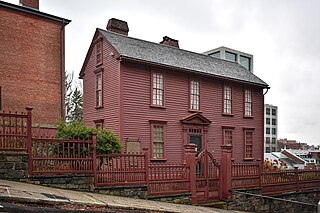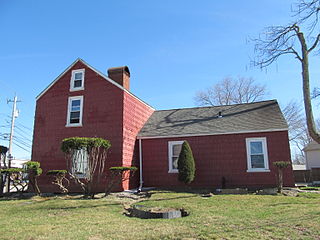
The Governor Stephen Hopkins House is a museum and National Historic Landmark at 15 Hopkins Street in Providence, Rhode Island. It was the home of Stephen Hopkins, a governor of the Colony of Rhode Island and Providence Plantations and a signer of the Declaration of Independence.

The Joseph Reynolds House is a historic house at 956 Hope Street in Bristol, Rhode Island, United States, built c. 1698–1700. The three-story wood-frame house is one of the oldest buildings in Bristol and the oldest known three-story building in Rhode Island. It exhibits distinctive, well-preserved First Period features not found in other houses, despite an extensive history of adaptive alterations. It is further significant for its use by the Marquis de Lafayette as headquarters during the American Revolutionary War. It was designated a National Historic Landmark in 1983.

The Clement Weaver–Daniel Howland House is a historic stone-ender timber frame house built in 1679. This rare example of primitive 17th-century architecture is located at 125 Howland Road in East Greenwich, Rhode Island. It is the oldest documented dwelling house in Kent County and the second oldest home in Rhode Island.

The William Mowry House is an historic farm house on Farnum Pike in North Smithfield, Rhode Island, United States. It is a 2+1⁄2-story plank-framed house, five bays wide, with a gable roof and a large central chimney. The main entrance is centered on the main (south-facing) entry, and is enclosed within a single-story hip-roof vestibule of 20th-century construction. A small single-story ell extends to the west of the main block. The interior follows a typical center-chimney plan, with the kitchen and parlor in the front of the house, and the dining room flanked by a small pantry and bathroom in the rear. The house was built c. 1802–05 by William Mowry, whose family has owned land in the area since the 17th century.

Benjamin Church House is a Colonial Revival house at 1014 Hope Street in Bristol, Rhode Island, U.S.A. It opened in 1909 as the "Benjamin Church Home for Aged Men" as stipulated by Benjamin Church's will. Beginning in 1934, during the Great Depression, it admitted women. The house was closed in 1968 and became a National Register of Historic Places listing in 1971. The non-profit Benjamin Church Senior Center was incorporated in June 1972 and opened on September 1, 1972. It continues to operate as a senior center.

The Taylor–Chase–Smythe House is a historic house on the Middletown portion of Naval Station Newport It is a two-story wood-frame structure, five bays wide, with a gable roof. A kitchen ell extends to the rear (north) of the house, and a glassed-in porch wraps around two sides of the house, ending in a porte-cochere. The house originally had a large central, chimney, but this was removed during alterations c. 1850. The house was built sometime in the second half of the 18th century by a member of the Chase family. The Chase property was acquired by the United States Navy in 1941, as part of an expansion of its facilities in Newport, and has been used since as military housing.

The Israel Arnold House is an historic house on Great Road in Lincoln, Rhode Island. It is a 2+1⁄2-story wood-frame structure, set on a hillside lot on the south side of Great Road. The main block is five bays wide, with a central chimney rising through the gable roof. A 1+1⁄2-story gambrel-roofed ell extends to one side. The ell is the oldest portion of the house, built c. 1720 by someone named Olney. The main block was built c. 1760. The house was owned into the 20th century by four generations of individuals named Israel Arnold.

See also Daggett House, Slater Park, Pawtucket RI, built about the same time, by Nathaniel's father John.

The Logee House is a historic house on 225 Logee Street in Woonsocket, Rhode Island. Built in 1729 by a French Huguenot family, this two-story wood-frame house is a rare early-18th-century house in the city, and one of its best-preserved. The main block follows a plan more typical of colonial Massachusetts houses, unsurprising given the land it stands on was once disputed between the two colonies. The main block has a central chimney, with single rooms on either side on both floors. An ell, probably 18th century in origin, extends from the rear, and a 20th-century porch adorns the front of the house.
The Potter–Remingston House is an historic house in Cranston, Rhode Island. It is a 2+1⁄2-story wood-frame structure, five bays wide, with a large central chimney, and a two-story ell attached to the west side. It is set on what was originally a 21-acre (8.5 ha) parcel of rolling woods and overgrown fields, adjacent to the Remington family cemetery. The outside of the house has relatively plain styling, but its interior public spaces include some elaborate Federal period woodwork. It is one of the few surviving 18th-century farm houses in Cranston.

The Stephen Allen House is an historic house on Sharp Street, on the northeast corner of its junction with Rhode Island Route 102, in West Greenwich, Rhode Island. The main block of this 1+1⁄2-story Cape style wood-frame house was built c. 1787 by Stephen Allen, a farmer. The house is five bays wide, with a central chimney and a center entry which is framed by a later Greek Revival surround. There is a 1+1⁄2-story ell extending to the east (right) of the main block. To the east of the main house stands what originally appeared to be a shed that has since been converted for use as a small horse stable. Evidence suggests this structure was built sometime before 1862 as a store.
The Peleg Champlin House is an historic house on Rodman Pond Lane in western New Shoreham, on Block Island, in Rhode Island. It is a 1+1⁄2-story wood-frame structure, five bays wide, with a side-gable roof and a large central chimney. An ell extends from the back (north) side of the house. The Federal style wooden house was built c. 1820 by Peleg Champlin, a farmer from one of the island's older families. The house is one of the best-preserved houses of the period on the island.

The Rathbun House is a historic house at 343 Beacon Drive in North Kingstown, Rhode Island. It is a 1+1⁄2-story wood-frame structure, five bays wide, with a large central chimney. Its exterior trim is simple and lacking in significant detailing. The interior plan is a typical five-room setup, with a narrow entry hall, two rooms on either side of the chimney, and the kitchen behind. It is one of a small number of surviving mid-18th century farmhouses in the town. It was probably one of four houses built in the area by members of the Rathbun family.

The Spink Farm is a historic farm at 1325 Shermantown Road in North Kingstown, Rhode Island. The only surviving element of the farmstead on this 55-acre (22 ha) farm is the main house, a 2+1⁄2-story five-bay wood-frame structure built in 1798 by Isaac Spink. The house exhibits modest Federal styling, its doorway flanked by small sidelight windows and simple pilasters, and topped by a shallow hood. The interior follows a typical center-chimney plan, with its original Federal period fireplace mantels intact. The house has been extended to the rear by a kitchen ell and porch, both added in the 20th century. The house is one of a small number of 18th-century farmsteads left in the town.

The Charles Payne House is an historic site in Pawtucket, Rhode Island. The house was built in 1855–56 by Charles Payne and later expanded with the addition of two ells and a porch. The 1+1⁄2-story Gothic-Italianate vernacular cottage is architecturally significant as a 19th-century vernacular cottage in a picturesque setting. Though the round-head picket fence and entry gates were later removed, the property retains a large shaded garden on with ample street frontage. The Charles Payne House was added to the National Register of Historic Places in 1983.

The Joseph Spaulding House is an historic house at 30 Fruit Street in Pawtucket, Rhode Island. It is a 1+1⁄2-story wood-frame structure, five bays wide, with a side-gable roof and a large central chimney. It is set in a hillside, and its basement, made of fieldstone, is used as an additional story. Built in 1828, with an ell added in 1850, it is one of the city's least-altered and best-preserved Federal style houses.

The Kingsley House is a historic First Period house at 108 Davis Street in Rehoboth, Massachusetts in the United States. The oldest portion of this house is estimated to have been built around 1680, making it the oldest structure in Rehoboth. It was listed on the National Register of Historic Places in 1983, where it is listed at 96 Davis Street.

The Haskell House, also known as the Andrew Clark House, is a historic house on Ross Hill Road in Lisbon, Connecticut. Built about 1798, it is a good example of transitional Georgian-Federal residential architecture. It was listed on the National Register of Historic Places on June 28, 1979.

The Jenckes House is a historic house at 81 Jenckes Hill Road in Lincoln, Rhode Island. It is a 1+1⁄2-story wood-frame structure, five bays wide, with a central chimney. A 20th-century screened porch extends to the right side of the house, and a modern kitchen ell extends to the rear. The house is an 18th-century construction by a member of the locally prominent Jenckes family.
Grouselands, also known more recently as the Waterman Farm, is a historic farm and country estate on McDowell Road in Danville, Vermont. The main house is a distinctive and rare example of Shingle style architecture in northern Vermont, and is the product of a major redesign of an Italianate farmhouse built in the 1860s. The house and immediate surrounding outbuildings were listed on the National Register of Historic Places in 1983.




















